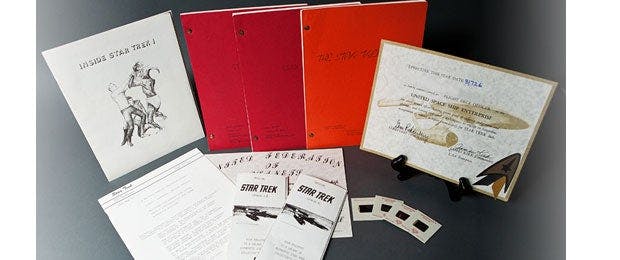Published Sep 7, 2011
A Collector's Trek #5: Lincoln Enterprises Merchandise
A Collector's Trek #5: Lincoln Enterprises Merchandise

Way back in 1977, a little movie called Star Wars ruled the world. It seemed everyone had Star Wars fever, seeing the film multiple times and buying up every piece of licensed merchandise that they could get their hands on. T-shirts, board games, action figures, cereal… If it had the Star Wars name on it, folks bought it. George Lucas, the film’s creator, led the charge on this merchandising bonanza. Lucas had the foresight to “sell” the film even if the studio had no interest in doing so, handling its merchandising himself and reaping the bountiful rewards. After the enormous success of Star Wars, Lucas’ form of self-promotion was hailed as one of the shrewdest business moves in entertainment history. But just as Gene Roddenberry preceded Lucas on the Sci-Fi front, so too did he beat Lucas to the punch on marketing his own work to the public… albeit on a much smaller scale.
Lincoln Enterprises (originally known as “Star Trek Enterprises”) came to prominence back in 1967. Originally set up to handle fan mail for Star Trek, the company quickly fell under Gene’s direct control after a piece of misdirected mail from legendary Sci-Fi writer Isaac Asimov. Asimov had written a personal letter to Gene which had somehow ended up in the fan mail department. Instead of a reply to his question, Asimov ended up with an autographed picture of the cast. A quick call from Asimov to Gene relayed the situation and Roddenberry decided that from that point forward he would take a personal interest in running Lincoln. Along with Majel Barrett, Gene would oversee the company, ensuring that it became an actual line of communication between the show and its fans. Right around this time, Desilu started pulling the purse strings on Star Trek a bit tighter. While it had been customary in the past for the studio to pay for publicity pictures to send out to fans, the increasing demands of budgetary constraints forced them to abandon this practice. Roddenberry, in a brilliant move of salesmanship, decided that if the studio was unwilling to pay for these highly demanded pictures, then perhaps the public might be willing to foot the bill. The response from Star Trek’s fans was resoundingly positive, and Lincoln Enterprises quickly increased their available items enough to fill small mailer catalogs. Here is a selection of some of the more memorable items featured in these early catalogs:The Star Trek Interstellar - “This is it- the direct line to Star Trek!” For the low sum of $3.50 in annual dues, a fan could become a member of the official Star Trek fan club. Included in the kit were a “personalized” letter from Gene, a Federation citizenship certificate, Star Trek stationery and stickers, a membership card, and 6 issues of the official newsletter, “Inside Star Trek.” Quite a bargain!Flight Deck Certificate - This 8 x 11” certificate came ‘signed’ by Captain Kirk and Gene Roddenberry and granted the bearer honorary membership to the USS Enterprise. Available in a standard blue version for $.50, or a deluxe version printed on parchment paper with insignia sticker and two-color ribbon for only $1.00.Star Trek Format - This “collector’s item” is truly one of the greatest bargains in the entire catalog. For only $1.00, a fan could own the original format description that sold Star Trek to the studio. Included in this format are Roddenberry’s original descriptions of the series along with many of the original story ideas. A fascinating read even today.Star Trek Scripts - In perhaps a television first, Gene and Majel decided to sell scripts directly through Lincoln Enterprises. These scripts were manufactured exactly as they were used in the show, all final shooting drafts with mimeographed pages and color covers. The cost per script was $5.50, or “super-fans” could order entire seasons of scripts at a discounted rate.Film Clip Frames - Undoubtedly, the coolest piece of merchandise available in the catalog were the 35mm film clip frames. In another brilliant merchandising move, Gene took the original first print dailies from the show, cut them into individual frames, and sold them through the Lincoln catalog. The film clips were sold in sets, with each group consisting of 8 shots of the designated character or object. No two frames were alike, and some frames actually contained behind-the-scenes images and deleted sequences not seen in the televised version of the show. At only $1 per set, this was easily one of the most popular items in the catalog. A fan felt like they truly owned a piece of the show when they purchased these film clips. Although many of the items carried in the catalog would be carried for years after the show went off the air, these film frames were only available for a relatively short time due to their unique, limited nature.
Foreshadowing Lucas' Star Wars merchandising self-control by 10 years, Roddenberry’s direction of Lincoln Enterprises granted him the opportunity to sell the show despite the studio’s reticence. Not only that, Lincoln offered a previously unheard of direct line of communication with the fans, which proved to be instrumental in keeping viewers updated on the status of Roddenberry’s television properties. Throughout Star Trek’s lush history, Lincoln Enterprises has been a constant mainstay. Today, it exists as Roddenberry.com, under the guidance of Gene and Majel’s son, Rod Roddenberry. So as we celebrate the last 45 years of Star Trek and turn our eyes to the future of the franchise, it’s comforting to know that Lincoln Enterprises is still there, too, providing us with a piece of the franchise to call our very own.
Want to read more from James Sawyer about Star Trek products? Check out his blog - A Piece of the Action.

